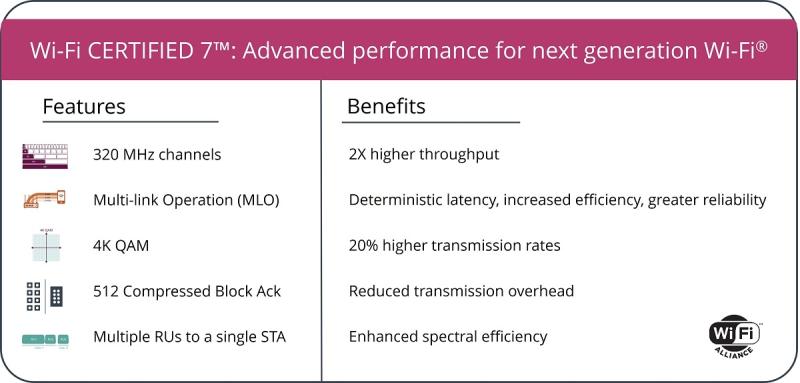Routers with Wi-Fi 7 are already available, but the Wi-Fi Alliance today announced the launch of its Wi-Fi 7 Certified program, which puts the organization’s stamp of approval on devices and verifies they’re interoperable with other Wi-Fi 7 products.
Of course, one can expect a lot of improvements with Wi-Fi 7, like going from roughly 10 Gbps to peak rates of over 40 Gbps.

But Kevin Robinson, president and CEO of the Wi-Fi Alliance, flagged one feature in particular: Multi-Link Operation (MLO), which allows devices to transmit and receive data simultaneously over multiple links, similar to what carrier aggregation does in the cellular world.
According to Robinson, there are two flavors of MLO. The first one involves aggregating multiple bands or channels.
“At a very high level, Multi-Link Operation allows a device to transmit and receive simultaneously on more than one link,” he said. For example, a laptop may have a link to 2.4, 5 and 6 GHz and transmit and receive on those frequencies simultaneously.
The second flavor is where the access point or client device is able to look at all of those same bands and make a decision as to which band or channel to send a latency-sensitive packet over based on which one is available the soonest, he said.
Wi-Fi 7 was built from the ground up to support operation in the 6 GHz band and in the U.S., the FCC designated the entire 6 GHz band for unlicensed uses. However, while Wi-Fi 7 will be deployed globally, not every region in the world supports 6 GHz for unlicensed gear. That was one of the big issues during the 2023 International Telecommunications Union (ITU) World Radiocommunication Conference (WRC-23) in Dubai late last year.
Wi-Fi 7 & CES
It’s no accident the Wi-Fi 7 Certified program is being announced ahead of tomorrow’s official opening of CES 2024 in Las Vegas. Expect to see plenty of devices on display on both the client and the access point/router side. “The time meshes really well with mass market devices coming to market,” Robinson said.
As with previous generations of Wi-Fi, earlier products made their way to market before the official launch of the certification program. What you typically see with the release of Wi-Fi Certified is kick-off to more mass market adoption and the Wi-Fi Alliance expects the same with Wi-Fi 7.
With regard to Multi-Link Operation, it's worth noting that the cellular and Wi-Fi industries have a long history of borrowing techniques from one another. For example, MIMO was on the Wi-Fi side and made its way to cellular. OFDM was on the cellular side and emerged in the Wi-Fi camp. “A lot of these techniques really do start blending into each technology,” he said. “That’s very normal.”
2024: The year for Wi-Fi 7
According to the Wi-Fi Alliance, Wi-Fi 7 will see rapid adoption across a broad ecosystem, with more than 233 million devices expected to enter the market in 2024, growing to 2.1 billion devices by 2028. Smartphones, PCs, tablets and access points (APs) are the earliest adopters of Wi-Fi 7. Customer premises equipment (CPE) and augmented and virtual reality (AR/VR) gear already are gaining early market traction.
The Wi-Fi Alliance’s Wi-Fi Certified 7 announcement includes quotes from Airties, Boingo Wireless, Extreme Networks and more. The organization said that Broadcom, CommScope Ruckus Networks, Intel, MaxLinear, MediaTek and Qualcomm form the test bed for certification and are among the first Wi-Fi Certified 7 devices.
Lumen Technologies got a jump on things and today announced that it was the first to receive Wi-Fi 7 certifications for two wireless devices for its Quantum Fiber residential and small business customers. The company said Quantum Fiber installed its first customer Wi-Fi 7 device in December.